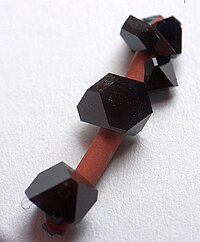Copper acetate
 Small crystals of copper(II) acetate
|
|
 Copper(II) acetate crystals on copper wire
|
|
| Names | |
|---|---|
|
IUPAC name
Tetra-μ2-acetatodiaquadicopper(II)
|
|
| Other names
Copper(II) ethanoate
Cupric acetate Copper Acetate Verdigris |
|
| Identifiers | |
|
142-71-2 (anhydrous) 6046-93-1 (hydrate) |
|
| 3D model (Jmol) | Interactive image |
| ChemSpider |
8555 |
| ECHA InfoCard | 100.005.049 |
| PubChem | 8895 |
| UNII |
39M11XPH03 |
|
|
|
|
| Properties | |
| Cu(CH3COO)2 | |
| Molar mass | 181.63 g/mol (anhydrous) 199.65 g/mol (hydrate) |
| Appearance | Dark green crystalline solid |
| Odor | odorless (hydrate) |
| Density | 1.882 g/cm3 (hydrate) |
| Melting point | Undetermined |
| Boiling point | 240 °C (464 °F; 513 K) |
|
hydrate: 7.2 g/100 mL (cold water) 20 g/100 mL (hot water) |
|
| Solubility | Soluble in alcohol Slightly soluble in ether and glycerol |
|
Refractive index (nD)
|
1.545 (hydrate) |
| Structure | |
| Monoclinic | |
| Hazards | |
| Safety data sheet | Baker MSDS |
| R-phrases | 22-36/37/38-50/53 |
| S-phrases | 26-60-61 |
| NFPA 704 | |
| Flash point | Non-flammable |
| Lethal dose or concentration (LD, LC): | |
|
LD50 (median dose)
|
710mg/kg oral rat |
| US health exposure limits (NIOSH): | |
|
PEL (Permissible)
|
TWA 1 mg/m3 (as Cu) |
|
REL (Recommended)
|
TWA 1 mg/m3 (as Cu) |
|
IDLH (Immediate danger)
|
TWA 100 mg/m3 (as Cu) |
|
Except where otherwise noted, data are given for materials in their standard state (at 25 °C [77 °F], 100 kPa).
|
|
|
|
|
| Infobox references | |
Copper(II) acetate, also referred to as cupric acetate, is the chemical compound with the formula Cu(OAc)2 where AcO− is acetate (CH
3CO−
2). The hydrated derivative, which contains one molecule of water for each Cu atom, is available commercially. Anhydrous Cu(OAc)2 is a dark green crystalline solid, whereas Cu2(OAc)4(H2O)2 is more bluish-green. Since ancient times, copper acetates of some form have been used as fungicides and green pigments. Today, copper acetates are used as reagents for the synthesis of various inorganic and organic compounds. Copper acetate, like all copper compounds, emits a blue-green glow in a flame.
Copper acetate hydrate adopts the paddle wheel structure seen also for related Rh(II) and Cr(II) tetraacetates. One oxygen atom on each acetate is bound to one copper at 1.97 Å (197 pm). Completing the coordination sphere are two water ligands, with Cu–O distances of 2.20 Å (220 pm). The two five-coordinate copper atoms are separated by only 2.62 Å (262 pm), which is close to the Cu–Cu separation in metallic copper. The two copper centers interact resulting in a diminishing of the magnetic moment such that near 90 K, Cu2(OAc)4(H2O)2 is essentially diamagnetic due to cancellation of the two opposing spins. Cu2(OAc)4(H2O)2 was a critical step in the development of modern theories for antiferromagnetic coupling.
...
Wikipedia

